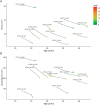Longitudinal Changes of Clinical, Imaging, and Fluid Biomarkers in Preataxic and Early Ataxic Spinocerebellar Ataxia Type 2 and 7 Carriers
- PMID: 39133883
- PMCID: PMC11361831
- DOI: 10.1212/WNL.0000000000209749
Longitudinal Changes of Clinical, Imaging, and Fluid Biomarkers in Preataxic and Early Ataxic Spinocerebellar Ataxia Type 2 and 7 Carriers
Abstract
Background and objectives: Brain MRI abnormalities and increases in neurofilament light chain (NfL) have mostly been observed in cross-sectional studies before ataxia onset in polyglutamine spinocerebellar ataxias. Our study aimed to identify longitudinal changes in biological, clinical, and/or imaging biomarkers in spinocerebellar ataxia (SCA) 2 and SCA7 carriers over 1 year.
Methods: We studied SCA2 and SCA7 carriers and controls (expansion-negative relatives) at the Paris Brain Institute. Inclusion criteria included Scale for the Assessment and Rating of Ataxia (SARA) scores between 0 and 15. Assessments at baseline, 6 months, and 12 months comprised neurologic, quality of life, orofacial motor, neuropsychological, and ophthalmologic examinations, along with gait and oculomotor recordings, brain MRI, CSF, and blood sampling. The primary outcome was the longitudinal change in these assessments over 1 year.
Results: We included 15 SCA2 carriers, 15 SCA7 carriers, and 10 controls between May 2020 and April 2021. At baseline, the ages were similar (41 [37, 46] for SCA2, 38 [28.5, 39.8] for SCA7, and 39.5 [31, 54.5] for controls, p = 0.78), as well the sex (p = 0.61); SARA scores were low but different (4 [1.25, 6.5] in SCA2, 2 [0, 11.5] in SCA7, and 0 in controls, p < 0.01). Pons and medulla volumes were smaller in SCAs (p < 0.05) and cerebellum volume only in SCA2 (p = 0.01). Plasma NfL levels were higher in SCA participants (SCA2: 14.2 pg/mL [11.52, 15.89], SCA7: 15.53 [13.27, 23.23]) than in controls (4.88 [3.56, 6.17], p < 0.001). After 1-year follow-up, in SCA2, there was significant pons (-144 ± 60 mm3) and cerebellum (-1,508 ± 580 mm3) volume loss and a worsening of gait assessment; in SCA7, SARA score significantly increased (+1.3 ± 0.4) and outer retinal nuclear layer thickness decreased (-15.4 ± 1.6 μm); for both SCA groups, the orofacial motor assessment significantly worsened. For preataxic and early ataxic carriers, the strongest longitudinal deterioration on outcome measures was orofacial motility in SCA2 and retinal thickness in SCA7.
Discussion: Despite the limitation of the small sample size, we detected annual changes in preataxic and early ataxic SCA individuals across brain MRI imaging, clinical scores, gait parameters, and retinal thickness. These parameters could serve as potential end points for future therapeutic trials in the preataxic phase.
Trial registration information: ClinicalTrials.gov NCT04288128.
Conflict of interest statement
The authors report no relevant disclosures. Go to
Figures



References
Publication types
MeSH terms
Substances
Associated data
LinkOut - more resources
Full Text Sources
Medical
Research Materials
Miscellaneous
